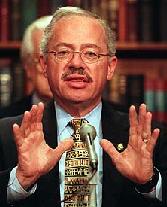As a preface to this post, you might want to take a glance over a mostly complete but rather alleatory sampling of the books that I was assigned to read during my high-school English career, which occurred during the heady crest days of the feminist education movement in the 1990s.[] (Note to English teachers: I am not complaining about this lineup in the least; the English program at AHS is one of the best parts of the school. This is intended merely as a counterpoint to certain claims made in the article being discussed.)
So, then, what have we here? Yet another heaping helping of Christina Hoff Sommers from Salon. I swear to God there must be some kind of law requiring Salon to publish one sloppy lovefest for media creation antifeminist Christina Hoff Sommers once every year (2/5/2002, 3/9/2001, 6/21/2000).
And it’s the same old thing they’ve been insisting in the last three articles: feminist education efforts in the 1990s have somehow slighted boys’ aspirations to a good education, and now it’s time to start tilting the balance
back the other way or somesuch nonsense. At hand is boys’ lower performance in verbal / literary subjects, compared with the narrowing of the advantage they once enjoyed in science and mathematics classes.
In this article, at least, the author allows voices other than Christina Hoff Sommers to speak (not the case in Befner’s regrettable Battle of the Celebrity Gender Theorists, an article allegedly about Jane Fonda and Carol Gilligan, which nevertheless consisted entirely of a sympathetic interview with Christina Hoff Sommers). However, it just so happens that Hoff Sommers and those who agree with her are given the last word in every case; allowed to skewer interpretations of data by Gilligan and other feminists, but given a free pass on truly bizarre statements.
This, for example, is reported without any comment from an opposing voice:
Our English classes are strongly feminized, even in boys schools
,
says Hoff Sommers. We want literature to make boys more sensitive.
But I’m not sure that we need to invest in literature as a form of therapy.
This claim is not just contentious; it’s downright bizarre. Look over my reading list[] again and ask yourself how much it’s really feminized
. The reading list is packed with literature of boys, by boys, and for boys. It used to be that learning from a reading list not very different from this one was expected to be part of the ritual of a boy growing up into manly adulthood in a civilized society.
She points out that a majority of English teachers still assign fiction in the
classroom, while she believes that boys prefer nonfiction. (In the PISA study,
girls and boys were asked to self-report on the kind of reading materials they
preferred. Boys reported reading more comic books, Web pages and
newspapers, while girls read more novels.)
Of course they primarily assign fiction. It’s an English literature class! If you want more nonfiction reading in schools, push to have more primary sources included in History, Science, Mathematics, etc. classes. That’s where it belongs. (And for God’s sake. Comic books? Please.)
Boys love adventure stories with male heroes,
says Hoff Sommers.
Many would love books by Stephen Ambrose and Tom Clancy. Since they
are so far behind in reading, why not give them texts they enjoy? Some
teachers are promoting political correctness at the expense of the basic
literacy of their male students.
Hoff Sommers mistakenly assumes here that the reason for not including Tom Clancy pulp in the English class is because teachers are craven p.c.
slaves. This is false. The reason Tom Clancy pulp is not included in English literature class is because it’s pulp fiction written on a third grade level. And no, encouraging Reading at all costs is not worth it–what in the world is developing an appreciation for Tom Clancy novels going to do for you, other than make you spend more money at the bestseller rack and get you a knowledge of military gadgetry? Similarly, boddice-rippers and Harlequin romance novels do not deserve to be, and are not, included in the English curriculum, either, even though they are intended for, and often written by, women.
My own son had to struggle through Amy Tan’s Joy Luck
Club when he was in the 10th grade,
she adds. It has some
attractive features, but it is full of annoying psychobabble about women and
their self-esteem struggles. He disliked it. If teachers are going to assign
books in popular literature, they should consider the needs and interests of
boys.
Hoff Sommer’s vehemence about The Joy Luck Club makes it pretty clear that she just hates the book and is projecting her own feelings of distaste for it onto a generation of boys. If she hates the annoying psychobabble
so much, then isn’t her real issue that it’s simply bad literature, not that it’s cutting against boys in particular?
Moreover, for Christ’s sake, in any English curriculum, there are going to be many books which you find absolutely dreadful and which bore you to tears. I, for example, was forced to wade through such dreary wank-a-thons as A Separate Peace and A Farewell to Arms. If the mere presence of some books you find boring is enough to turn you off to all literature, then you need to learn how to stop whining and get through to the next book.
Meanwhile, Tom Mortensen makes the astoundingly bad suggestion that
If I were teaching,
says Mortenson, I would get boys out of the
classroom. Take them to a swamp, dig through the muck, look for pollywogs.
Then maybe take them back and have them look at pond water through slides
and write up a lab report. They need hands-on activities. They get bored and
distracted if you ask them to sit down and reading a chapter and writing up a
paragraph — the kind of work that girls excel at.
Take them to a swamp? Dig through the muck? If I were subjected to this kind of treatment in school, I would have dropped out by fifth grade. You know what I love? Sedentary desk work. Reading a chapter and writing up a paragraph about it. Boring, dry textbooks. Who does he think he is teaching, the Lost Boys from Peter Pan? This is not a way to encourage serious education amongst boys; it’s a way to get a lot of boys goofing off and throwing mud at each other. Christ, man. Pollywogs?
(Furthermore, Mortensen’s proposal about how to change science education neglects the fact that boys are doing just fine in science education relative to girls. What hands-on
activities does he propose we use to deal with disparities in literature? Take boys out to the moor to muck around and fetch wittles while they read Great Expectations?)
Meanwhile, Christina Hoff Sommers ridicules the perfectly reasonable hypothesis by Carol Gilligan that In American culture, says Gilligan, children learn to associate math and science with masculinity; knowledge of the human world and emotional lives are associated with femininity.
Why should this be so surprising? It’s definitely true that English curricula are perceived as feminized
. But this is not a matter of the reading list being somehow weighted heavily towards girl-power-chic titles, because, well, that’s crap. There is no such bias in English curricula. The issue, rather, is that in boy culture, reading literature and poetry is seen as a feminine
activity, and it’s a good way to get yourself derided as a sissy
, faggot
,geek
, dweeb
, and otherwise un-manly boy. This, I think, is the only explanation that even remotely makes sense: why else would anyone think that, say, reading John Donne in English class is a feminized
curriculum? And if this is the case, then jamming Tom Clancy pulp or comic books into the curriculum isn’t the way to solve the problem. The way to solve the problem is to address the boy culture nonsense which sees reading as girly, and sees being perceived as girly
as a curse to be avoided.
Finally: let’s drop the crisis rhetoric, and let’s forget this nonsense about feminist educators being responsible for the situation. Why? Because the disparity in literature education has existed as long as the Department of Education has records, since 1969 (when the organized feminist movement barely existed in politics, let alone in education). The gap has not opened out or widened in the past 10 years; there is no new crisis
of boys’ verbal / literary education from feminist educators in the 1990s. There’s merely a disparity which was there before and which has not been addressed yet.
But, of course, Salon has a long history of providing an uncritical platform for media-created anti-feminists including Christina Hoff Sommers, Cathy Young (a regular columnist), Camille Paglia, and Warren Farrell. I can’t put it better than Jennifer Pozner of FAIR did, in her letter to the editor of Salon (located at the bottom of the page):
After listing worthy topics from drug law imbalances to welfare policy to
educational and workplace biases, Sweeney asks, Where is a feminist
when you need one? On a beach somewhere, apparently …
With all
due respect, it is easy to find feminists working on those issues and a wide
range of others if you look beyond what is represented in carping book
reviews and academic arguments. But it is unsurprising that Sweeney or
Salon readers in general might believe feminists missing in action: Salon
provides a regular platform for anti-feminist pit bull Camille Paglia and
feminist ankle-biter Cathy Young, but has no feminist columnists addressing
the many ways in which women’s rights advocates are tackling violence
against women, poverty, health care, child care, reproductive rights, media
representation, workplace issues, sweatshops, trafficking in women and a host
of other issues on a national and international stage (from a variety of
sometimes opposing liberal, progressive and radical perspectives).
I couldn’t agree more with Sweeney’s assertion that neurotic rationalizing
and self-conscious crowing
is a profound waste of time in the face of the
continued biases women (especially women of color and low-income women)
face. To that end, I’d encourage Salon to publish fewer hit pieces on feminists,
more articles about sexism in Life and in the news sections, and to balance
columnists like Paglia, Young and Horowitz with a few progressive feminist
writers like Molly Ivins, Laura Flanders, Katha Pollitt, Farai Chideya, Barbara
Ehrenreich or Julianne Malveaux. Salon, which is often a valuable resource for
perspectives not found elsewhere (Greg Palast’s election pieces were a great
example), could benefit from broadening its approach to gender politics.
— Jennifer L. Pozner, Women’s Desk Director, FAIR
P.S.: While women are excelling boys at verbal and literary subjects, and now make up the majority of college students (college students being, in the majority, liberal arts students), engineering and science departments are still about 80-90% male, and men still make more money than women for equal work (the gap has widened in at least some fields, despite Salon’s claims to the contrary) and still make up the overwhelming majority of high-paid executives — whereas women still make up the overwhelming majority of low-wage service workers. So, something tells me that this educational crisis
is perhaps not the biggest gender equity issue on the table right now.
For further reading:

